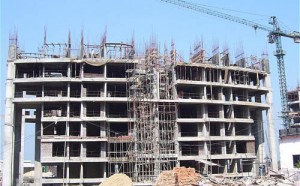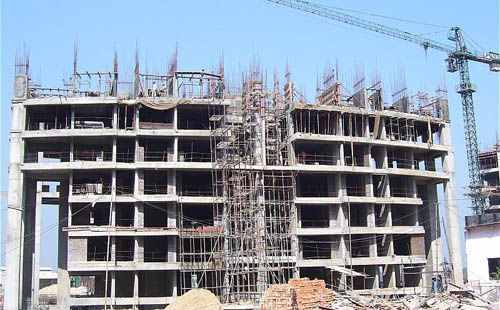By: Anshuman Magazine, CMD, CBRE South Asia
 Track2Realty: Although the Interim Budget announcement supporting affordable housing was welcomed by the real estate industry, the segment has a long way ahead as yet. To begin with, there is considerable supply shortage in this arena—pegged at 18.78 million for the 12th Five Year Plan (2012–2017) by the Ministry of Housing and Urban Poverty Alleviation Ministry (HUPA), of which 96% is in the EWS and LIG categories. Housing shortage for the EWS stands at almost 11 million homes, while that for LIG stands at 7.41 million homes.
Track2Realty: Although the Interim Budget announcement supporting affordable housing was welcomed by the real estate industry, the segment has a long way ahead as yet. To begin with, there is considerable supply shortage in this arena—pegged at 18.78 million for the 12th Five Year Plan (2012–2017) by the Ministry of Housing and Urban Poverty Alleviation Ministry (HUPA), of which 96% is in the EWS and LIG categories. Housing shortage for the EWS stands at almost 11 million homes, while that for LIG stands at 7.41 million homes.
Fairly recently, the government had set up a committee to develop a slum index at the city, state and national levels to sharpen its policy focus on the urban poor. Slum data (source: HUPA) released in March 2013 for Census 2011 had pointed out that around one out of every six households in urban India (17.4%) lived in a slum. It had also shown that well over a third of all slum households (38%) were in cities with a population in excess of a million.
A key push was given to the housing sector, with the allocation of INR 6,000 crore for the Rural Housing Fund, and INR 2,000 crore for the Urban Housing Fund, at the Interim Budget 2014–15. However, with a substantial amount of funds already allocated for the creation of affordable and/or low-cost, mass housing in the previous fiscal left unused, the effective utilization of fund allocation for affordable housing cannot be stressed enough.
According to HUPA, as of February 20, 2013, as against a target of 3.10 lakh beneficiaries with a total outlay of INR 1,100 crore, approximately 13,485 beneficiaries had been benefitted with a net present value (NPV) of interest subsidy of INR 16 crore. Additionally, although about INR 2,000 crore had already been allocated to the Urban Housing Fund, the National Housing Bank (NHB) is yet to set up this fund.
Rajiv Awas Yojana (RAY)
The Cabinet Committee on Economic Affairs approved the launch of the Rajiv Awas Yojana (RAY) as a Centrally Sponsored Scheme (CSS) to be implemented during 2013–2022. It also approved the continuation of Affordable Housing in Partnership Scheme (AHP) as part of RAY, with amendments. It was decided to continue the Interest Subsidy Scheme (ISS) for Housing the Urban Poor (ISHUP) and rechristening it as the Rajiv Rinn Yojana (RRY).
As of January 31, 2014, a total of 121 projects had been under the preparatory as well as implementation phases under RAY—across 19 states/union territories and 84 towns/cities—at a total project cost of INR 5,010.20 crore for housing and infrastructure projects. Of this total approved amount, about INR 462.49 crore have been released for various projects, while INR 905.00 crore is yet to be released.
Earlier central assistance under the scheme was limited to INR 50,000 per dwelling unit or 25% of the cost of all civic services (external and internal), whichever was lower. This assistance was to be given as subsidy for project developers both in the private as well as public sectors. As per the recommendations of the Affordable Housing Task Force (AHTF), the scheme has been amended to provide INR 75,000 per EWS/LIG dwelling unit for housing and internal development components, with an objective to improve private sector participation in affordable housing.
RAY has also been empowered to extend financial support to states for the creation of affordable housing stock through PPP under the Affordable Housing in Partnership (AHP) component of the scheme. Under this AHP scheme for the period 2011–2013, about 11 affordable housing projects across Rajasthan (eight projects in Jaipur) and Karnataka (three projects in Bangalore) were in progress at a total approved project cost of INR 231.33 crore, as of January 31, 2014. This translates to about 6,768 affordable dwelling units, of which 1,920 have been completed and 4,848 units are under construction. For bridging an urban housing shortage of almost 18 million homes for the EWS/LIG segment, these figures fall woefully short.
Rajiv Rinn Yojana (RRY)
The Interest Subsidy Scheme (ISS) for Housing the Urban Poor (ISHUP) has been continued as the RRY as a standalone Central Sector Scheme, with a fund allocation of INR 32,230 crore during the 12th Five Year Plan. This is a provision of a fixed interest subsidy of 5% on interest charged on the admissible loan amount to EWS and LIG segments to enable them to buy or construct a new house or for carrying out any additions to the existing building. It proposes to provide interest subsidy of 5% on long tenure loans of 15 to 20 years, limited to INR 5 lakh borrowed by EWS/LIG; with a ceiling of INR 8 lakh loans for the LIG. HUPA has set a target of around a million households through the RRY over a period of four years at an estimated outgo of approximately INR 45,000 crore.
Till the year ending June 30, 2013, NHB as a nodal agency, had disbursed NPV of subsidy amounting to INR 8.17 crore covering 9,126 beneficiaries across eight states under the Scheme (Report on Trends and Progress of Housing in India 2013, NHB).
At the risk of reiterating the same point, although the government has put in place various funds and bodies to bridge the enormous housing shortage gap in urban India, much more needs to be done as far as implementing these policies are concerned.
Despite the total outstanding housing loan portfolio with Housing Finance Companies (HFCs) in 2012–13 increasing by 30.69% to INR 2,90,427 crore (NHB Annual Report, March 31, 2013)—out of the total housing loans disbursed by PSUs in 2012–13, those of less than Rs. 5 lakh barely stood at 10%. Furthermore, housing loans as a percentage of Gross Bank Credit for Scheduled Commercial Banks (as of March 31, 2013), stood at just about 9.25%.
A major reason for this might be inaccessible financing options for the EWS/LIG segment of urban India. Almost 70% of potential low-income home buyers have informal income avenues, but need access to housing loans to buy a home. Needless to say, traditional financial players do not service this vast group. Growing interest in low-income housing finance is a very recent phenomenon; and it’s taken till 2011–12 for new entities, private players and established financial institutions to make an entry into the market.
For all intents and purposes, therefore, government funds and schemes for mass housing are perhaps the only recourse for India’s teeming urban populace. Recent developments have seen the NHB planning to refinance banks and HFCs for rolling out long-term fixed rate loans of up to INR 10 lakh to borrowers for a period of 15–20 years. The intent behind developing this product is to specifically protect low and moderate income households against prevailing volatility in floating rates on housing loans.
Relaxing the current FDI policy in the construction sector has been in the pipeline since November 2013. The major policy revisions awaited include easing the three-year lock-in period for FDI in housing and townships; reducing the minimum capitalization to US$5 million (from the earlier US$10 million) for wholly-owned subsidiaries; and trimming the minimum area of construction projects to a carpet area of 20,000 sq.m (from a built-up area of 50,000 sq.m). Once approved, developers facing liquidity issues will benefit from investments in housing projects as it will likely be easier for a wider gamut of projects to become eligible for foreign funding. One can only hope that India’s new political dispensation will work towards implementing these key policy initiatives, with better ground results.





